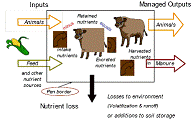Biological Systems Engineering, Department of

Department of Agricultural and Biological Systems Engineering: Presentations and White Papers
Date of this Version
August 2006
Document Type
Article
Abstract
Runoff from open lot livestock systems (beef and dairy) defined as Concentrated Animal Feeding Operations (CAFO) must be controlled by systems designed and managed to prevent the release of manure-contaminated runoff for storms equal to or less than a 25-year, 24-hour design storm. This performance standard has been attained for open lot systems with some combination of clean water diversion, settling basins, runoff collection ponds and irrigation systems (baseline system).
An alternative approach is to rely on overland flow and infiltration into cropland with perennial forage or grasses for treatment of open lot runoff. Such vegetative systems have been researched since the late 1960s. This paper reviews the research literature on vegetative treatment systems (VTS) for managing open lot runoff summarizing available science on system performance, design and management.
Based upon this review of the literature, the following conclusions are drawn about the application of VTS to manage runoff from open lot livestock production systems:
• Substantial research (approximately 40 identified field trials and plot studies) provides a basis for understanding the performance of VTS. A superior research knowledge base exists for performance of VTS as compared to baseline systems for CAFO regulation compliance.
• The baseline systems for CAFO regulation compliance perform well in the High Plains regions of the U.S. where significant moisture deficits exist (rainfall minus evaporation). However, the performance of these baseline technologies drops substantially for decreasing moisture deficits found in the central and eastern Corn Belt states. These trends have been established through computer modeling processes but not confirmed with in-field performance measurements.
• The existing research targeting VTS is confined to non-CAFO applications, likely due to past regulatory limits. Unique challenges exist in adapting these results and recommendations to CAFO applications.
• The pollutant reduction resulting from a VTS is based upon two primary mechanisms: (1) sedimentation, typically occurring within the first few meters of a VTS, and (2) infiltration of runoff into the soil profile. Systems relying primarily on sedimentation only are unlikely to perform equal or better than baseline technologies. System design based upon sedimentation and infiltration is necessary to achieve a required performance level for CAFO application.


Comments
Paper presented at the Animal Agriculture and the Environment: National Center for Manure and Animal Waste Management White Pappers. J. M. Rice, D. F. Caldwell, F. J. Humenik, eds. 2006. St. Joseph, Michgian: ASABE. Pub. Number 913C0306. Copyright © 2006 R. Koelsch, J. Lorimor, and K. Mankin.